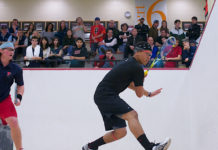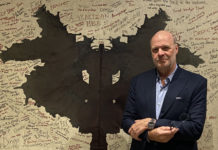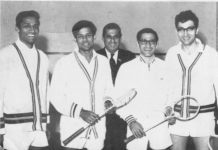By Nell Schwed
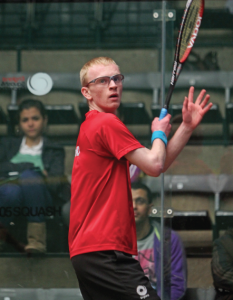
Squash is many things, but what it first brings to mind—besides its elitist roots, genteel style and winter vegetable connotation—is the competitive edge it can provide a college applicant.
Typically, those schools who fall under the umbrella of strong squash programs are only allotted two recruiting spots for each varsity team. Though some schools may field teams of twenty players or more—see the deep teams of Trinity and Princeton—no athletic scholarships exist in the Ivy League or the New England Small College Athletic Conference (NESCAC), whose schools have some of the most accomplished squash programs.
At schools like Harvard or Yale, with incredibly strong academics and squash programs, the successful recruiting process is thought to be the most difficult. Recruits must have both the academic profile and squash skills to be admitted to the school—not always the easiest balance between school work and squash lessons, not to mention the arduous college application process and commitments to weekend tournaments, or any other extracurricular activity that can distract.
Applicants, and their parents, always want to know their chances of admission. How high do my SAT scores have to be? What about my GPA? Mathematically, what do I have to do to guarantee a thick envelope in the mail?
And the truth is, there isn’t a set formula, an input or an output that will tell you if your dream school wants you too. There are calculators that can compare you to past applicants (acceptees and rejectees) and “confidential” message boards where you can share your stats and debate chances of admission, but there isn’t an app that can tell you exactly why one person gets in and another doesn’t.

Many believe that squash is a secret backdoor—though not so secret anymore—to top colleges. The New York Times, Washington Post, and Wall Street Journal have all covered this supposed revolution in extra curricula. And if you were to look at the data: top junior players across five seasons of play (2008-2013) and where those players ended up for college, you too would be convinced of its efficacy in competitive college admittance.
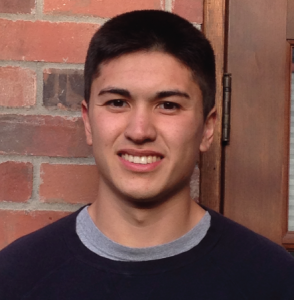
This is nothing to say of the institutional biases that accompany squash and its recruiting process. It is an expensive sport: equipment, lessons, travel, and tournament fees, all add up. It is not a sport that offers college scholarships, so those players seeking financial support have to rely on need-based financial aid, merit scholarships (if offered), work-study or some combination—all without being able to compare packages between schools. While coaches may continue to recruit through regular decision, most recruits know where they will head by November, if not earlier.
However, just looking at the numbers and counting the colleges top players attended, doesn’t tell you the whole story. Rankings, tournament exposures, points accrued, can only tell you so much about a player. So, Squash Magazine took a moment to speak with a few recruits from the incoming Class of 2018, to gain some better, more on the ground perspective.
Abigail Shonrock, future member of the women’s team for George Washington University, No. 9 in the nation and recent Kurtz Cup Champions, when asked what she would change about the game, lamented: “I wish that squash was more recognized through the U.S. Many people don’t know what it is or even that GWU, or lots of other great colleges for that matter, even have teams!”
Shonrock started playing squash just eight years ago at The Cynwyd Club in Philadelphia, inspired by her younger brother’s foray into the sport. “But really,” Shonrock admits, “I learned to enjoy the sport from my first coach, Shane Coleman. I didn’t think squash would be a big part of my life because I was very involved with soccer at the time, and I didn’t think about playing squash in college until my sophomore year in high school.”

Shonrock began her recruiting process by taking tours of schools and meeting with coaches. She talked to former teammates of hers who had successfully navigated the college process—”I’m so happy I had help from teammates before me who had gone on to college. Teammates are great people to talk to.”
Shonrock also stresses the importance of time management—”My advice to student athletes is to use a planner or calendar. Keeping track of your commitments can be difficult, but practice makes perfect.” And a final piece of advice for potential recruits? Shonrock says, “Keep your options open and keep an open mind! There are so many amazing schools with fantastic varsity squash programs. Tour the campuses, talk with various coaches, talk with other players you meet at tournaments or high school match events, and talk with your local club professional.”
College squash programs, including club and emerging teams, are increasing at an exponential rate. With the growing popularity of the sport, so come the teams that need players to field them and spots for recruits to fill.
Omar Mussehl, future member of George Washington University men’s squash team and marathon Harry Potter reader, started playing in his hometown of Seattle at the downtown YMCA, but says, “I knew if I wanted to play squash competitively I had to go the East Coast.” Squash may be growing across the country, with pockets of play on the West Coast and in the Midwest, but the East is still the reigning hotspot for the sport. Mussehl, who did not travel for any tournaments and was relatively unknown on the circuit, says he had to reach out to coaches, instead of them reaching out to him. Rather than rely on his ranking—seventy-four at its highest in the Boys’ Under-17 division in the 2009-10 season—Mussehl sent a video of himself playing to coaches.
 Though initially Mussehl was unsure about playing squash in college, “I knew I was good enough to play. I think playing every day against people my age, all fighting for a spot to play, will help my game a lot. The team aspect of college squash will be a lot different than the everyman for themselves aspect of junior squash.”
Though initially Mussehl was unsure about playing squash in college, “I knew I was good enough to play. I think playing every day against people my age, all fighting for a spot to play, will help my game a lot. The team aspect of college squash will be a lot different than the everyman for themselves aspect of junior squash.”
And for those juniors looking to play in school, Mussehl advises: “Have a good work ethic. Just because you made it to college does not mean you can slack off.” Mussehl joins a team ranked No. 20 in the nation, with hopes to cross the C to B division divide through to the No. 15 spot.
Lauren Kotin, enthusiastic globetrotter and recruit for the women’s team at Brown University, currently No. 11 in the nation, had her first squash lesson in the eighth grade at the New York Sports Club on 86th Street and Lexington. Kotin says, “After that initial experience, I knew I loved squash and refused to pick up a tennis racquet because I thought that the two were incompatible.” She continues, “There was just something about the game that was unique, strategic, almost like a puzzle. And yet, it was somewhat familiar because it consisted of a racquet, an opponent, and a ball, like tennis. It is more than just power and core; you need to constantly use your mind to figure out the best place to aim, keeping all the angles of the walls and patterns of your opponent in mind. You have to think ahead of the next shot, and still watch your opponent’s every move.”
Kotin did not expect to be recruited, but hoped for the opportunity. She attended squash camps in the summer—including her future coach, Stuart LeGassick’s program in Scotland. The two kept in touch after the camp and into Kotin’s senior year, as she was particularly drawn to Brown’s strong academics, diverse community, and enthusiastic student body. Kotin found out about her acceptance while driving in the car with her family, saying, “We were visiting my brother, and I just said, ‘Oh my god!’ I read them all the email, and reread and reread it, extremely excited and a bit in shock!” Kotin notes, “When looking at schools, squash was important but not necessary. I loved the game, and figured that if I wasn’t recruited, I would find a way to keep up my game.”
She’s also looking forward to the team aspect of college squash—something she did not have in high school. “I think college squash will be more fun and supportive than junior squash. I found junior tournaments intimidating and often unsettling due to parents who were overly aggressive and consumed by their children’s efforts. It often made playing squash unenjoyable and unnecessarily stressful. I hope that college squash will help me become part of a close-knit group that consists of people who have a common interest in the game of squash and competition, and yet still manage to genuinely support one another.”
In advising future recruits, Kotin says, “Don’t listen to anyone’s voice but your own. It is more important to be happy and enjoy everything that you do, than to satisfy someone else’s goals. It will all work out!”
Charlie Blasberg, an improv enthusiast and recruit for the men’s team at Brown University, currently No. 18 in the nation, started playing squash so long ago, he says, “it seems that I’ve been playing for my whole life.” With a very early entry onto the squash scene—picking up a racquet at age three or four—encouraged by squash playing parents (mother Jeanne Blasberg, first woman Board Chair of US Squash) and an older brother who was also recruited to play at Brown, Blasberg’s own recruitment seemed inevitable. Blasberg kept his commitment close to the chest—”When I found out I got a spot on the Brown team, I didn’t tell my parents. They had been riding me pretty hard that fall with college stuff, and I was sick of it. I think I waited a day or two to tell them that I had committed to Brown, and they didn’t believe me when I told them.”
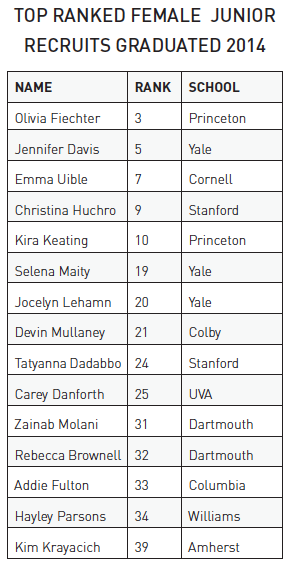 Blasberg contacted coaches at schools he was interested in saying, “Some replied. Others didn’t. It was always great when a coach was honest and straightforward with me. Even if they were delivering bad news, I’d rather get it without any nonsense.” For future college players, Blasberg recommends: “You have to love the game. If you are sick of squash by the time you get to college, or you are just using squash to help you get into school, you are doing all the wrong things. College squash is a lot of time on court and with other squash players and if you don’t absolutely love it, you are wasting your time.”
Blasberg contacted coaches at schools he was interested in saying, “Some replied. Others didn’t. It was always great when a coach was honest and straightforward with me. Even if they were delivering bad news, I’d rather get it without any nonsense.” For future college players, Blasberg recommends: “You have to love the game. If you are sick of squash by the time you get to college, or you are just using squash to help you get into school, you are doing all the wrong things. College squash is a lot of time on court and with other squash players and if you don’t absolutely love it, you are wasting your time.”
Most college squash players commit to between two and three hours every day while in season, not including time spent traveling to matches, or national events—a fair chunk of any student’s schedule.
Zainab Molani, Midwest Squash Championship finalist in 2014 and recruit to Dartmouth College, currently No. 8 in the nation, says, “I always knew I would play squash in college. I just had to find the right college for me and in the end I did.”
Molani actively pursued being recruited by squash coaches—she emailed those at schools she was interested in, made a video, kept up in tournament play and went on official visits—adding, “I really liked the visits because it gave sort of an inside view into what life would be like if I were to go to a certain school and if I would fit in well or not.”
The hardest moment for Molani came her junior year of high school, traveling on the road for tournaments and keeping up with her school work proved a difficult balance, but Molani credits the community that surrounded her: “I was fortunate enough to have teachers that understood my situation and gave me homework I knew I would miss ahead of time, so that I could get it done early. It was tough, but my friends, family and teachers were very supportive and helped me get through what I needed to get done.”
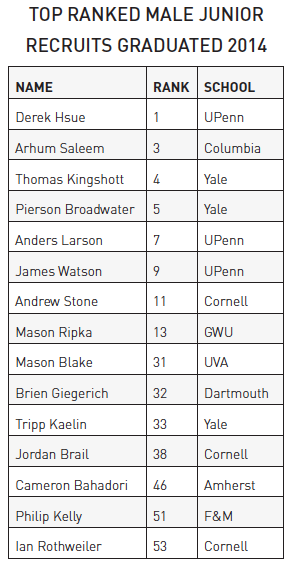 Molani is a Midwestern player, living in Illinois, which made it difficult for her to travel to tournaments, as most were based on the East Coast, forcing her to sacrifice school time and weekends to squash. Though she started playing the sport young, at just eight years old, Molani didn’t find her squash-competitive streak until middle school—”It was definitely tough to make the transition from non-athlete to athlete because before I played squash I had only done intramural sports and then some soccer, ice skating, and gymnastics…so not much in the way of specific sport training.”
Molani is a Midwestern player, living in Illinois, which made it difficult for her to travel to tournaments, as most were based on the East Coast, forcing her to sacrifice school time and weekends to squash. Though she started playing the sport young, at just eight years old, Molani didn’t find her squash-competitive streak until middle school—”It was definitely tough to make the transition from non-athlete to athlete because before I played squash I had only done intramural sports and then some soccer, ice skating, and gymnastics…so not much in the way of specific sport training.”
But Molani took to the challenge and trained hard for squash; now a successful recruited athlete at a top school. She’s also excited for the team aspect—”I haven’t gotten to play on a team before whereas a lot of the other girls I know from the East Coast had the opportunity to play on their high schools’ teams. The team dynamic is going to be great for motivation and it provides a group of friends from the beginning of school as well.”
For junior players and potential recruits, Molani advises, “Don’t give up. I feel like that’s pretty standard advice, but to be honest it really helps in tough times to remember how far you have come and how close you are to getting where you want to be.”



